#Scandinavian folklore
Explore tagged Tumblr posts
Text
For people who like to make up different races of the same fantasy creatures like forest elf and dark elf and such, you’d have traditional Scandinavian folklore on your side if you made merpeople in the north have a sexual dimorphism where mermen are smaller than mermaids.
For some reason mermen are always described as being about the size of a child in early folklore. They’re absurdly easy to catch and people in the stories tend to take them home and keep them for a while because mermen could predict the weather. The merman eventually dies or tricks his captors into taking him back to the sea. So opposite mermaids who lured and drowned people mermen were considered pretty harmless and even useful if caught.

625 notes
·
View notes
Text
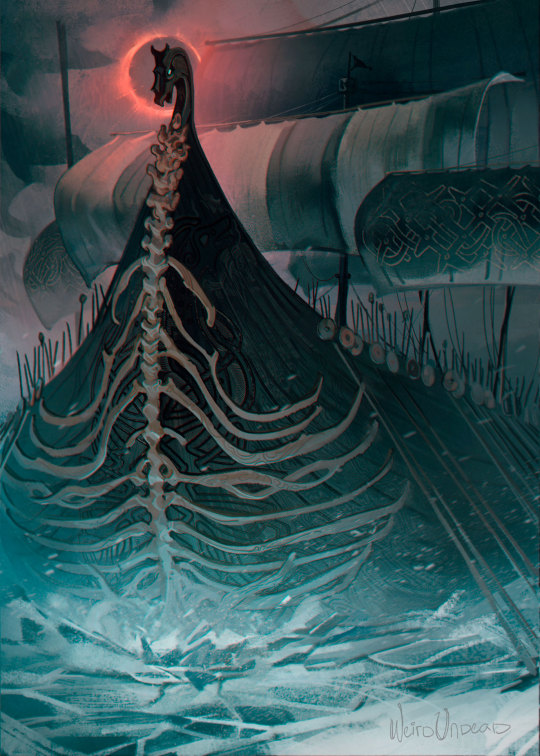
Naglfar, the harbinger of Ragnarök
1K notes
·
View notes
Text

Inktober Day 4
Been a while since Ive drawn nordic/scandinavian folk lore creatures, perhaps expect more this month 🫶
#original art#inktober#inktober 2024#nordic folk lore#scandinavian folklore#scandinavia#huldra#nordic#artists on tumblr#traditional illustration#traditional art#norwegian folklore#hulder#ink art#ink drawing
140 notes
·
View notes
Note
Dear ABC: a relative of mine recently visited Iceland, ignorant of the risk of evil whales, and while she was delighted to discover that their Christmas celebrations center around a family of marauding trolls called the Yulelads and their horrible cat that eats people who don't get clothes for Christmas, she was heartbroken to learn shortly afterward that the only depictions of them that they let tourists see are sanitized versions with rosy cheeks that DON'T traumatize children. Do you, perchance, have any fun Icelandic Yule monster folklore I could provide to cheer her up?
Aha, well, there's always different depictions of things of course. I do like Hlidberg's art for the Jólaköttur, it looks suitably brutish.

As you requested specifically Icelandic folklore, these - the cat, the lads, and Gryla - are the primary Yuletide monsters. But if you were to expand your scope a bit further, you'll find that there is no end of scary beings that want to cause you harm at Christmas. You don't even have to go too far to find that the Yule Goat in Norway also takes those who have not received new clothes, and in Sweden it bites those who have had too much Christmas dinner, giving them indigestion.
86 notes
·
View notes
Text

Pesta traveled from town to town, bringing disease wherever she appeared. At times, she left entire villages devoid of life, ravaged by the great pestilence.
#ink art#manga art#traditional art#fantasy art#mythology and folklore#horror art#norwegian folklore#scandinavian folklore
109 notes
·
View notes
Text

I started this painting August ninth. It’s now November fourteenth. It has been uncooperative to say the least. But honestly, I’m happy with how it finally came out.
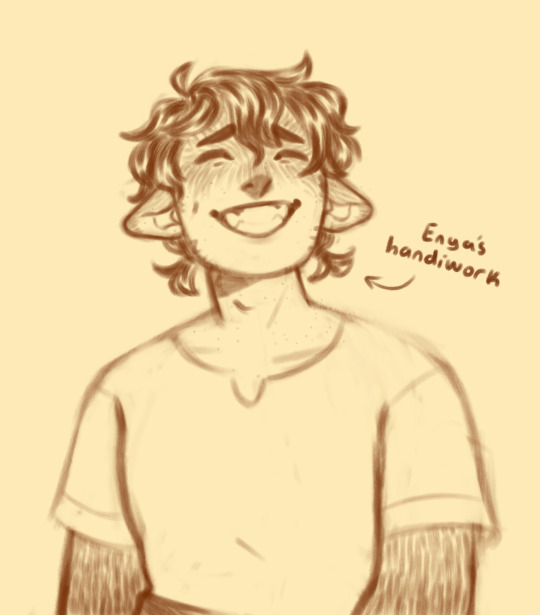
Also, Faas with pigtails because.
#this’s the first time I’ve drawn him properly smiling#he’s existed for over a year#and i feel bad that I haven’t let him smile ;-;#his character just doesn’t emote tons#but.#look at him#he’s so happy#also I’m sorry I haven’t posted actual art in a while#I’m in the stage of chipping away at fifty WIPs at once#and trying to finish them before the new year#and finishing art for the shop update#and#artists on tumblr#small artist#my art#digital art#character design#regular style#faas art#enya art#troll changeling#changeling#changeling art#kelpie#kelpie art#troll#scandinavian folklore#creature design#nordic folklore#folklore
65 notes
·
View notes
Text
Did Christianity Steal From Paganism? Yes... No... It's Complicated. Part 2: Vikings
Tis the season so I figured I'd talk about the topic that's been the subject of debate for a long time, most recently with the 2024 Olympics. I will be discussing the visual aspect of these religions, not the theological aspects.
Short answer: Yes
Long answer: No
Let's get into it: The Viking era is from 800-1050 AD and can be divided into seven parts based off the style of visual art that was popular. The first style is called the Oseberg style (775-800 AD) and would be the basis of all the Viking styles of art after it. It was made of three forms that were derived from Pagan pre-Viking art: ribbon animals, gripping beasts, and ambiguous forms. You can see it on the bow of the ship below; the ship dates to the 9th century and was found in a burial mound in Tønsberg, Norway. Remember these forms because they're going to be important later.
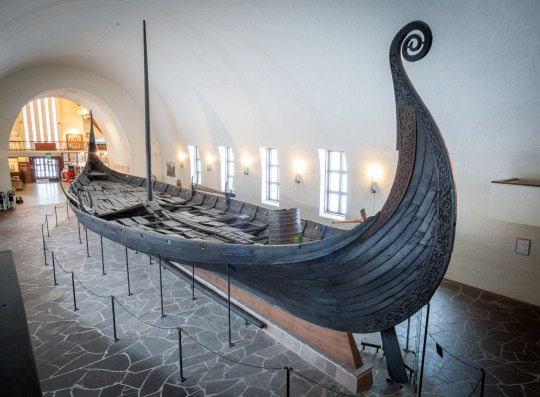
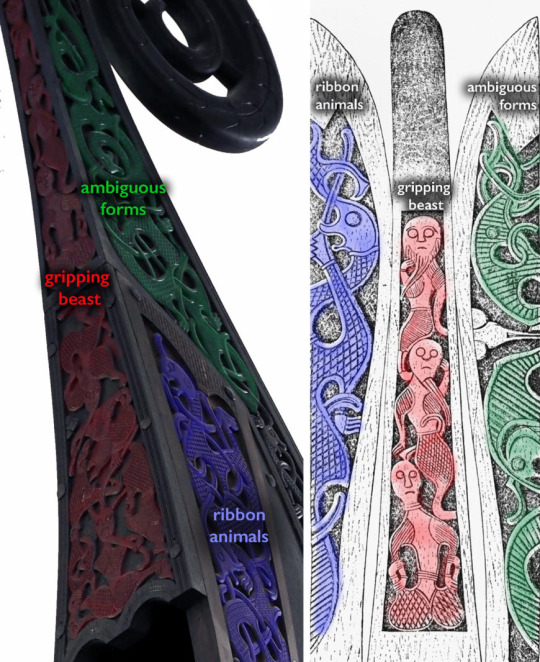
The Vikings started coming into contact with Christian Anglo Saxon (modern day English) missionaries in the 700-800s, but they had little effect. The missionaries were well received by the kings but when their Pagan chieftains threatened to rescind their support, the missionaries were sent away. Another example of that is in 878 AD, the Christian king of the Anglo Saxons, Alfred the Great of Wessex, and the Pagan king of the Vikings, Guthrum the Old, were at war. King Alfred ended up winning and as part of the peace treaty, Guthrum had to get baptized into Christianity. He did so but maintained his Pagan worship and did not implement Christianity.
Besides the kings, common people had also started to slowly assimilate to Christianity. Christians had a rule that they couldn't trade with Pagans so Pagan Vikings began primsigning. Primsigning is an old Norse word meaning "to make the sign of the cross," the way to show you followed Christian beliefs before converting all the way through baptism. Even though they weren't being baptized and were still practicing Paganism, primsigning was enough for Christians to feel comfortable trading with them and brought the Vikings more into the world of Christianity.
An interesting example of this is in Kopparsvik, Sweden, where a large number of Viking individuals were buried in a prone position from 900-1050 AD. This is completely different from traditional Pagan Viking burials: there were no grave goods, no animal sacrifices, no mighty ships. Typically, a prone position is a sign of showing humility towards God and all the figures had notches carved into their teeth (below). Historians theorize that they used the notches to secretly signal to Christian merchants that they were also Christian to get discounts while not being alienated from their Pagan communities.
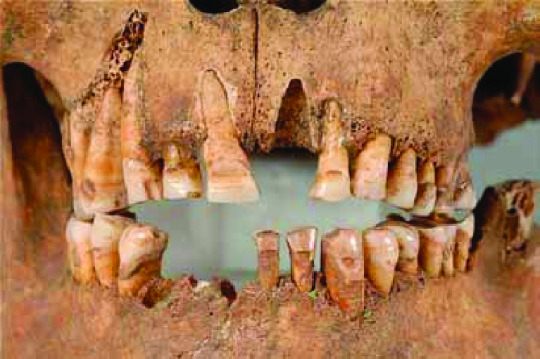

The coin below is from ~921 AD. It's a Viking coin from York, England and wonderfully shows the mixing of Pagan and Christian iconography. Coins like this typically had the name of the Viking king engraved on them but this one has "St. Peter." However, it also depicts the hammer of Thor on both the head (left) and reverse (right). It really demonstrates the visual mixing of religions.
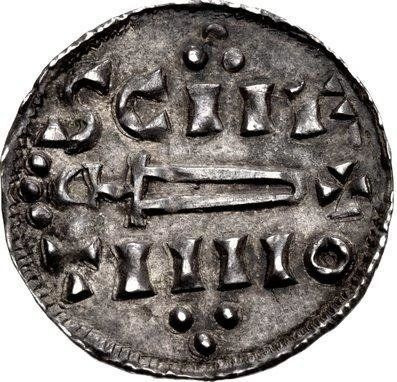
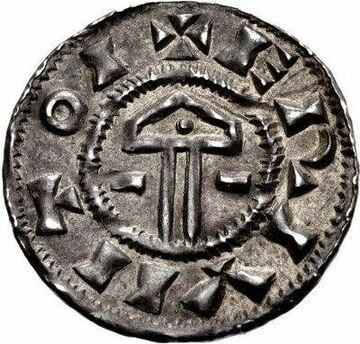
Sometime between 940-1000 AD, the cross below was made. It was found in St Andrew's Church, Andreas, Isle of Man (between England and Ireland), and is another great example of the combination of Pagan and Christian art. On one side (left) it depicts Odin with one of his ravens fighting the wolf Fenrir at Ragnarök. The other side (right) depicts Christ triumphing over Satan. Both of these are stories of good vs evil and depict a god triumphing at the end of days. It would have drawn attention to the theological similarities between Christianity and Norse Paganism, making it easier for people to conflate the differing theologies.
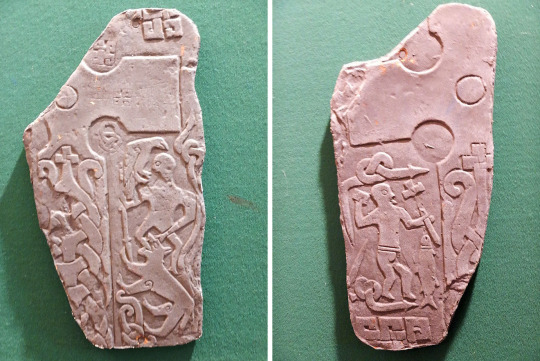
Remember the Oseberg style from before? We're going to revisit it. By the 900s, Viking art was being done in the Mamman style; the ribbon animals and gripping beasts had combined into an icon called the Great Beast. The Great Beast was a symbol of power and strength, frequently put on longships and other Pagan items. In 986 AD, Viking King Bluetooth, a recent convert to Christianity, had the jelling stone below erected in honor of his deceased parents. On one side, he included a Great Beast; this was to show the strength and nobility of his parents and the nation they ruled. On the other side, he put an image of Christ Triumphant. This makes sense for a cenotaph as the promise of a resurrection is a comfort in the face of death. But the combination of a Pagan symbol of strength and an image of Christ is very interesting; it's doing more than pointing out the similarities between the two religions, it's uniting both Pagan and Christian subjects under his rule and proudly displaying the two different sources of the Viking's strength.
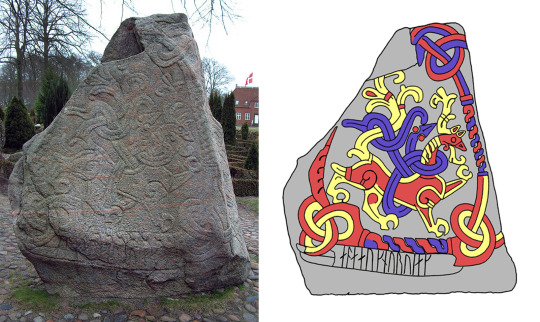
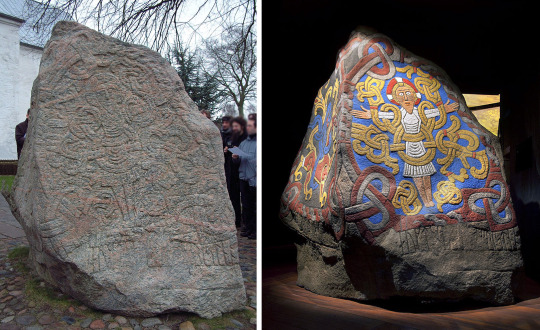
I can't end this without also talking about architecture. The last Viking art style is called the Urnes style and it's primarily because of the church below. It was built in 1132 AD in Urnes, Norway and is a stave church, meaning the whole thing was built without any nails!! The entire thing is self-supporting wood made using the post and lintel system. It's a Chrisitan church but has Pagan iconography on the sides: the last version of the Great Beast (right) and Pagan runes. It's fascinating how a Christian place of worship is decorated and protected by Pagan icons, once again showing the combination of visual cultures and methods of thought.
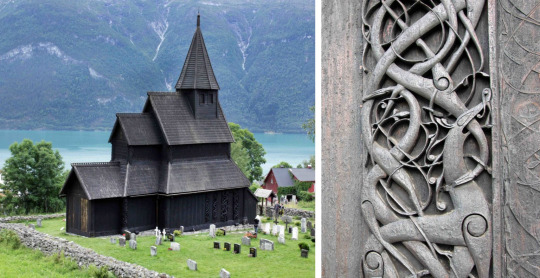
So, the answer everyone is looking for is NO.
The Christians didn't steal anything from the Pagans, they made an association. They produced art in the style that was popular and followed the artistic trends of the time. Christian and Pagan imagery was produced in the same medium and combined until Paganism was phased out over hundreds of years. They saw similar gods and iconography and combined them to make a message that was understandable to all audiences.
Happy Yule! Happy Winter Solstice!
Further reading:
Smarthistory – Art of the Viking Age
BBC - History - Ancient History in depth: Viking Religion
The Vikings and Christianity | History of Christian Vikings – Sons of Vikings
Treaty of Wedmore - Wikipedia
Manx runestones - Wikipedia
Prone Burials and Modified Teeth at the Viking Age Cemetery of Kopparsvik - Historische Beratung Dr. Matthias Toplak
Ancient Viking Art - Medievalists.net
Gamla Uppsala - Wikipedia
#i tried to include both academic and general further readings#this is very simplified bc i'm trying to give a general overview#yule#artist talk#ancient art#pagan witch#paganism#pagan#paganblr#christianity#norse paganism#celtic paganism#norse mythology#celtic mythology#norse art#celtic art#scandinavian folklore#scandinavian mythology#thor#odin#jesus christ#norse heathen#heathenism#winter solstice
63 notes
·
View notes
Text

Thor’s fishing trip🌞
#artwork#art#original art#thor#norse mythology#jormundgandr#folklore#mythology and folklore#mythology#scandinavian folklore#my art#thor odinson#illustration#scandinavian mythology
65 notes
·
View notes
Text

Völva for the Scandinavian-themed artbook ✨🔥 ✨
#when the main character of the drawing is a decorative frame#digital art#illustration#digital arwork#mythology#völva#seeress#scandinavian folklore#artists on tumblr#my art
285 notes
·
View notes
Text


I put my social realism-horror comic "Left Out" up on itch !!! 12 pages, originally published in an anthology back in 2023.
click to read.
#lesbian artist#horror comic#indie comic#short comic#horror story#churchlamb#church lamb#scandinavian folklore#scandinavian folkhorror#folkhorror#folk horror#kirkelammet
67 notes
·
View notes
Text
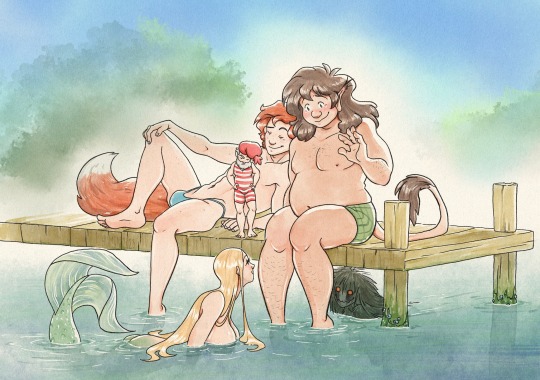
All of them are acting like you’d expect them to according to Scandinavian folklore: The gullible troll, the flirty huldrakarl, the suspicious gnome, the untrustworthy mermaid, and the creepy åmand (stream man or man of the stream)
Additional info: Trolls in Scandinavian folklore aren’t big dumb monsters but more like strong, less bright people of the woods/mountains. Huldrakarl is the less famous male version of the huldra. Gnomes are house spirits who help and protect the family they live with and are often the first to notice if something is off. Scandinavian mermaids are specifically said to have huge breasts which they use to lure sailors to their deaths. Though they’re often confused for each other Åmand is different from Näcken because more often than not he’s only heard but never seen, and will usually loudly announce that he plans to take a life days or even weeks before someone drowns in his waters.
And I just realized there are a lot of creatures with weird tails in Scandinavian folklore…
#troll#huldra#huldrakarl#mermaid#gnome#Neisse#åmand#folklore#scandinavian folklore#Denmark#Sweden#Norway#art
2K notes
·
View notes
Text
"A man in Linköping was accused of having copulated with the tree spritits in the middle of the 1640s, an accusation that it is hard to defend oneself from. The same pattern shows up in later stories about people who unknowingly got married off to a tree. By hiring a someone who was skilled in magic, a lovesick but rejected person could prevent their beloved from marrying someone else. Usually a lock of hair from the beloved and a short cylindrical piece of wood with their name carved into it was needed [for the ritual]. The items were buried under a pine tree while powerful magic formulas were chanted. This engaged the beloved to the tree, which meant that they could not marry someone else."
- Per Österman, Svenska jätteträd och deras mytologiska historia
36 notes
·
View notes
Text

"Klappa hund" ("petting the dog") the absolute quickest ms paint doodle on my phone before bed
#my art#art#digital art#ms paint#pixel art#sketch#doodle#artists on tumblr#gnomes#scandinavian folklore#scandinavian mythology#tomtar#animals
41 notes
·
View notes
Text

The Skogsra, also called the Hulder, live deep in the forest, feasting on the souls of men who follow after them. Skogsra look almost human but can be distinguished by their short tail and a hollowed-out back.
#ink art#manga art#traditional art#fantasy art#mythology and folklore#scandinavian folklore#artists on tumblr
51 notes
·
View notes
Text
scandinavian trolls

While the word "troll" was used to describe a variety of creatures from folklore and communities of people, trolls in folklore are generally described as ugly creatures that come in many shapes and sizes (some are described to have as many as nine heads), as well as appearing extremely old. They are also commonly portrayed as stupid and slow-witted creatures that can easily be outwitted, but are also usually very strong. However, other trolls are described to look and behave almost exactly like a normal human.
Trolls are usually said to live in isolated rocks, mountains, under bridges, the bottom of lakes, or caves, as well as burial mounds. Trolls that live in the mountains are described to be very rich, as they hoard gold and silver in their homes. Their homes are generally located far away from human civilization. However, unlike the rå or näck, they do have their own form of social organization and often live in small families.
The belief of trolls is believed to derive from the Old Norse beings called the jötunn (giants), although there is also a tale of Bragi meeting a troll woman. Both groups are described to be living in similar locations/environments, have similar social organization, and are rarely helpful or friendly. The Old Norse terms jötunn, troll, þurs, and risi are often used interchangeably, so the distinction between then are unknown (although one theory on origins says that trolls are mythical magicians).
Trolls are seen as generally dangerous, especially after the Christianization of Scandinavia. Many stories of trolls show them kidnapping and overrunning a farm/estate, as well as eating people. Trolls are believed to be afraid of lightning as well, likely alluding to Thor's role in fighting jötunn. However, as a result of Christianization, the absence of trolls in society is attributed to the ringing of church bells (although they left with resistance, destroying many churches in the process). In addition, many large rocks in Scandinavia are attributed to trolls, as they are believed to turn to stone in sunlight. Even in modern society, many believe in trolls.
References
https://en.m.wikipedia.org/wiki/Troll
https://sv.wikipedia.org/wiki/Troll
#trolls#paganism#witchcraft#baby witch#beginner witch#pagan#witch#witchblr#paganblr#norse pagan#norse witch#scandinavian folklore
23 notes
·
View notes
Text



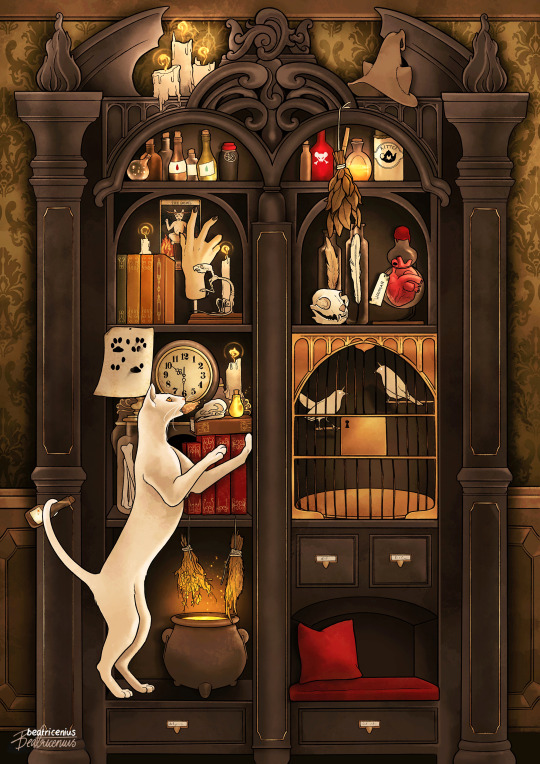
A small collection of drawings that aren't really connected, but feel like they could be
My Patreon
229 notes
·
View notes